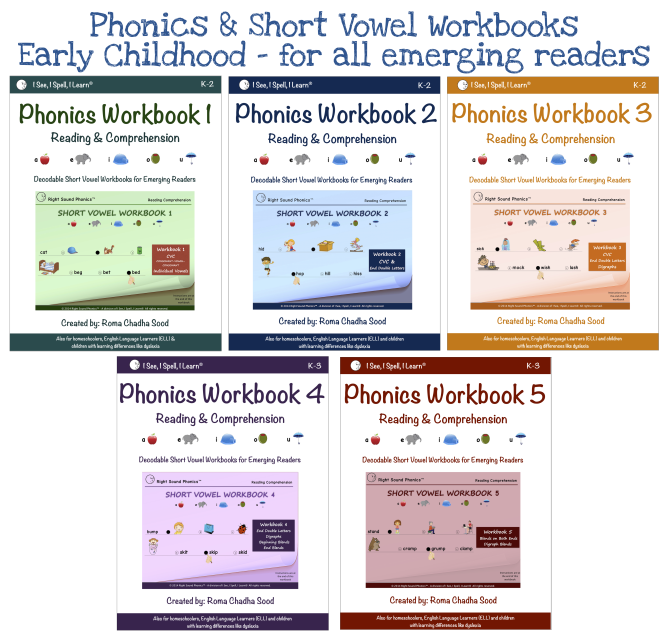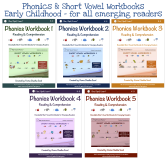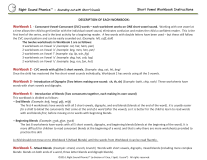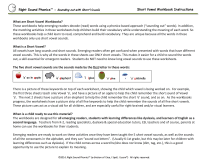- Phonics Workbooks - All Emerging Readers
- >
- Combo Phonics & Short Vowel eWorkbooks 1 to 5 - PDF Download - For All Learners K-2 (Five eWorkbooks Bundle)
Combo Phonics & Short Vowel eWorkbooks 1 to 5 - PDF Download - For All Learners K-2 (Five eWorkbooks Bundle)
SKU:
SVWBE12345
$47.45
$33.22
$33.22
On Sale
Unavailable
per item
What are Short Vowel Workbooks?
These workbooks help emerging readers decode (read) words using a phonics-based approach (“sounding out” words). In addition, the matching activities in these worksheets help children build their vocabulary while understanding the meaning of each word. So these workbooks help a child learn to read, comprehend and build vocabulary. They are unique because all the words in these workbooks only use short vowel sounds.
Each workbook has 24 pages of activities, along with an answer guide to each page.
What is a Short Vowel?
All vowels have long sounds and short sounds. Emerging readers often get confused when presented with words that have different vowel sounds. This is why all the words in these sheets use ONLY short vowels. This makes it easier for a child to sound the words out, a skill essential for emergent readers. Students do NOT need to know long vowel sounds to use these worksheets.
The five short vowel sounds are the sounds made by the first letter in these words:
’a’ as in apple
‘e’ elephant
‘i’ igloo
‘o’ olive
‘u’ umbrella
There is a picture of these keywords on top of each worksheet, showing the child which vowel is being worked on. For example, the first three sheets teach only Vowel ‘a’, and have a picture of an apple to help the child remember the short sound of Vowel ‘a’. The next 2 sheets have a picture of an elephant to help the child remember the short ‘e’ sound, and so on. As the workbooks progress, the worksheets have a picture strip of all five keywords to help the child remember the sounds of all five short vowels. These picture cues act as a visual aid for all children, and are especially useful for right-brained and/or visual learners.
When is a child ready to use this material?
The workbooks are designed for all emerging readers, students with learning differences like dyslexia, and learners of English as a second language. Teachers from K-2, reading specialists, dyslexia & special education tutors, ESL teachers and of course, parents at home can use the workbooks for their students.
Emerging readers are ready to work on these activities once they have been taught the 5 short vowel sounds, as well as the sounds of all the consonants in the alphabet, and they can “sound out letters”. (Usually K-1st grade, but this may be later for children with learning differences such as dyslexia). If the child comes across a word he/she does nor know (dim, tag, etc.), this is a good opportunity to use the picture to explain its meaning.
Enjoy!
These workbooks help emerging readers decode (read) words using a phonics-based approach (“sounding out” words). In addition, the matching activities in these worksheets help children build their vocabulary while understanding the meaning of each word. So these workbooks help a child learn to read, comprehend and build vocabulary. They are unique because all the words in these workbooks only use short vowel sounds.
Each workbook has 24 pages of activities, along with an answer guide to each page.
What is a Short Vowel?
All vowels have long sounds and short sounds. Emerging readers often get confused when presented with words that have different vowel sounds. This is why all the words in these sheets use ONLY short vowels. This makes it easier for a child to sound the words out, a skill essential for emergent readers. Students do NOT need to know long vowel sounds to use these worksheets.
The five short vowel sounds are the sounds made by the first letter in these words:
’a’ as in apple
‘e’ elephant
‘i’ igloo
‘o’ olive
‘u’ umbrella
There is a picture of these keywords on top of each worksheet, showing the child which vowel is being worked on. For example, the first three sheets teach only Vowel ‘a’, and have a picture of an apple to help the child remember the short sound of Vowel ‘a’. The next 2 sheets have a picture of an elephant to help the child remember the short ‘e’ sound, and so on. As the workbooks progress, the worksheets have a picture strip of all five keywords to help the child remember the sounds of all five short vowels. These picture cues act as a visual aid for all children, and are especially useful for right-brained and/or visual learners.
When is a child ready to use this material?
The workbooks are designed for all emerging readers, students with learning differences like dyslexia, and learners of English as a second language. Teachers from K-2, reading specialists, dyslexia & special education tutors, ESL teachers and of course, parents at home can use the workbooks for their students.
Emerging readers are ready to work on these activities once they have been taught the 5 short vowel sounds, as well as the sounds of all the consonants in the alphabet, and they can “sound out letters”. (Usually K-1st grade, but this may be later for children with learning differences such as dyslexia). If the child comes across a word he/she does nor know (dim, tag, etc.), this is a good opportunity to use the picture to explain its meaning.
Enjoy!





